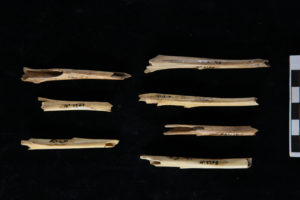
By examining new collections of fossilized leporids – a family of animals that include rabbits and hares – at various sites in the northwestern Mediterranean, scientists have provided some of the earliest evidence for human exploitation of small, fast game in Europe. According to the authors, their data* indicates that leporid exploitation in the Mediterranean region occurred in the Late Middle Pleistocene, earlier than previously assumed. And although ungulates – generally considered to have been the mainstay of the human diet at the time – may still have been the main source of the archaic hominin diet, these findings suggest archaic Homo groups had a broader diet during this period than previously thought. It is generally assumed that, before the Upper Paleolithic in Western Europe, archaic hominin diets consisted almost entirely of ungulates and not small fast game, which have lower return rates – in terms of calories offered for time spent hunting – compared to ungulates. Here, Eugene Morin and colleagues restudied this hypothesis by examining 21 new fossil assemblages from eight sites in the northwestern Mediterranean. All but one of the assemblages featured large numbers of leporid remains. Additionally, 17 out of the 21 (81%) assemblages showed some evidence of cutmarks (evidence of human hunting) and many of the marks were observed on meat-bearing bones like the humerus and femur. Notably, the majority of the assemblages lacked evidence of carnivore and raptor activity, further indicating the bones were processed not by animals, but by humans. Morin et al. also compared their new leporid collections to previously published assemblages and discovered that their new ones showed fewer cutmarks, which could suggest a change in site occupation and/or food preparation methods, the authors say. The evidence of leporid exploitation presented in this study raises questions about archaic Homo foraging behavior, Morin and colleagues say.
________________________________

Rabbit long bone tubes from the cave site of La Crouzade, southern France. The ends from these bones were probably snapped off by humans in order to extract marrow from the shaft cavity. EPCC-CERPTAUTAVEL
________________________________
Article Source: Science Advances news release
*“New evidence of broader diets for archaic Homopopulations in the northwestern Mediterranean,“ by E. Morin; J. Conolly at Trent University in Peterborough, ON, Canada; E. Morin; D. Cochard at Université de Bordeaux in Pessac, France; J. Meier at University of North Florida in Jacksonville, FL; K. El Guennouni at Laboratoire de Préhistoire Nice Côte d’Azur in Nice, France; A.-M. Moigne; L. Lebreton at CNRS in Paris, France; A.-M. Moigne; L. Lebreton at Muséum National d’Histoire Naturelle in Paris, France; L. Rusch at Université de Perpignan in Tautavel, France; P. Valensi at CNRS in Tourrette-Levens, France; P. Valensi at Musée de Préhistoire in Tourrette-Levens, France.





